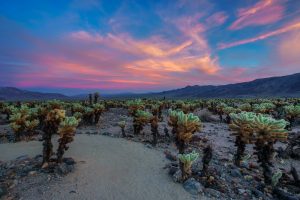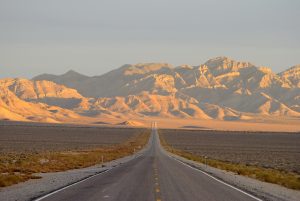More Than Just Vegas: Stuff You Might Not Know About Nevada
6 reasons the Silver State is different from all others

The state of Nevada is home to about 3 million people—75% of whom live in Clark County, home to the Las Vegas-Paradise metropolitan area. It’s known as the Silver State, and it’s also known for the engineering marvel—the Hoover Dam, the National Automobile Museum and the famous “Welcome to Las Vegas” sign. But there’s so much more to Nevada! Here are six things we think put Nevada in a category unto itself.

The Mojave Desert
The Mojave Desert encompasses 30 million acres of springs, canyons, streams, sand dunes and woodlands. It is a hot-cold dessert, meaning that it gets very hot in the summer and extremely cold in the winter. On average, it receives only about five inches of precipitation each year, making it the driest desert in North America. The plant and animal life in the Mojave Desert have adapted in unique ways to be able to thrive and survive in this dry environment. The desert is home to slow-growing Joshua trees, which are actually succulents. They grow to between 20 and 70 feet tall and live for around 150 years. Mistletoe also thrives in the Mojave, (I know, right?!) and it acts as a parasite toward the trees on which its seeds fall. Over 2,300 plant species are found in the Mohave, and 25% of those are found nowhere else on earth.
The camel spiders—also called “wind scorpions”—make their home in the Mohave, and the creepiest thing about them is that they can run up to 10 miles per hour! The desert is also home to the golden eagle, the desert bighorn sheep, and the short-horned lizard.

Area 51
The infamous Area 51 is located in the southern part of Nevada, 83 miles north/northwest of Las Vegas in the middle of the barren desert. The gate that leads to the secure area is laden with “No Trespassing” signs, and ahead of the gate on the hilltop sit “eyes in the sky” that monitor activity in the area, including would-be trespassers and visitors. If you’re feeling lucky and considering trying that luck at getting up close and personal with Area 51, don’t. It’s nearly impossible to get close, and you definitely won’t get to the base. Security guards monitor the grounds, and F-16 fly-bys let you know you’re being watched. In short, there’s no cloak of invisibility when it comes to trespassing on this government land, and if you’re caught, you will be rewarded with heavy fines and possibly arrested.
So what exactly is Area 51? Simply put, it’s a United States Air Force facility—a highly classified remote part of Edwards Air Force Base within the Nevada Test and Training Range. The base’s primary purpose is not publicly known, but based on historical evidence, it’s likely used to support the development and testing of concept aircraft that is not yet in use. Until June 25, 2013—in response to a Freedom of Information request from 2005—the CIA didn’t even publicly acknowledge the existence of Area 51, which is formally referred to as Honey Airport and Groom Lake, per the CIA.
The secrecy surrounding Area 51 has fueled conspiracy theories and UFO folklore. Myths have surrounded the location for years. Some allege that the wrecked spacecraft from the Roswell incident in 1947 is housed in a hangar at Area 51. It is also believed by some that the government is studying extraterrestrials, entering into joint undertakings with extraterrestrials, developing ways to control the weather and engaging in other activities as part of the secret Majestic 12 organization.
They say truth is stranger than fiction. But in this case, the truth is most likely more boring than the fictional theories and myths.

Las Vegas
“Sin City” they call it. Las Vegas—where whatever happens stays right there, or so they say. The city is home to nearly 650,000 people. But the real action is on the strip—a 4.2-mile-long stretch of roadway in Clark County, Nevada, that’s lined with resorts, casinos, hotels, and restaurants. If gambling is your bag, you’ve probably had your sights set on Vegas once or twice. Or perhaps you’ve visited a few times. But the real fun is probably for the people who visit and don’t gamble. Because they want you to save your money for the slots and tables, you can eat very well on the Las Vegas strip without breaking the bank. You can even find great resort rates. Again, they’d like for you to spend less on those things so you can put the real money on the tables.
There are also lounges, nightclubs, and shows on the strip, as well as shopping, rides and attractions and even golf clubs and courses!

The Federal Government owns most of Nevada
The United States Government owns approximately 85% of the land in the state of Nevada. That accounts for about 58,226,000 of its 70,000,000 acres. The land is owned by the Bureau of Indian Affairs, the Bureau of Land Management, the Bureau of Reclamation, the Department of Defense, the Department of Energy, Fish and Wildlife Services, Forest Services, and the National Park Service.
In contrast, the government owns only 1.1% of the land in Nebraska, 1.8% of Texas, 4.0% of Georgia and 2.6% of Alabama. The government owns more of the state of Nevada than of any other state in the union.

The Comstock Lode
The Comstock Lode refers to a lode of silver ore located beneath the east slope of Mt. Davidson in the Virginia Range in Nevada. The Comstock Lode was the first major discovery of silver ore in the country. The discovery was made public in 1859—10 years after the Gold Rush of 1849 in California. The discovery sparked a surge of prospectors in Nevada—each one coming to the area to stake his claim in the silver fortune that had been announced. Production from the Comstock mines from 1859 to 1878 was worth a whopping $320,000,000 with a net profit of $55,000,000, and most of that was made in the 1870s alone. Not only did the Comstock Lode put the area on the map for its silver, but it also helped to advance mining technology. Square set timbering and the Washoe process (for pulling silver from the ore) both resulted from the Comstock Lode.

Less precipitation than any other state
The state of Nevada receives less precipitation per year than any other state in the country. With a statewide average annual amount of precipitation of only 10 inches, it wins the title of driest state in the union. But that amount can be somewhat deceptive, given that in the southeast part of Nevada, only about 4 inches of rainfall in a year. But as many as 50 inches of rainfall on the high peaks of the Sierra Nevada Mountains annually. In contrast, the state of Hawai’i receives about 64 inches of rain annually, and Texas receives almost 29 inches. So yes, as statewide averages go, the Silver State is by far the driest of these United States.




